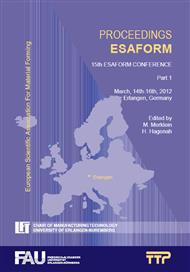p.77
p.83
p.89
p.95
p.101
p.107
p.113
p.119
p.125
Failure Prediction in Sheet Metal Forming Depending in Pre-Straining and Bending Superposition
Abstract:
The automotive industry nowadays, uses numerical simulation systems to determine process safety of car body parts. Forming simulations are usually used to predict local necking and cracks during the deep-drawing operation or to calculate the spring-back behaviour. Furthermore, FEA is also used for optimizing the hemming process. In this contribution, further development and the use of an enhanced failure criterion for the evaluation of flanging and hemming processes are shown. This criterion describes material failure caused by incipient surface cracks on the bending edge keeping the predominant bending load conditions in consideration. The investigations of the bending conditions in this criterion include loads from previous forming operations and geometrical aspects, such as bending radii. The approach presented in this contribution can deliver a more reliable prediction regarding the expected material failure.
Info:
Periodical:
Pages:
101-106
Citation:
Online since:
February 2012
Authors:
Price:
Сopyright:
© 2012 Trans Tech Publications Ltd. All Rights Reserved
Share:
Citation:


